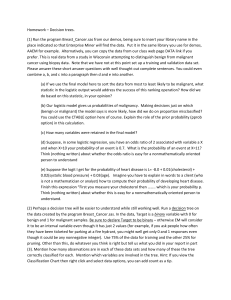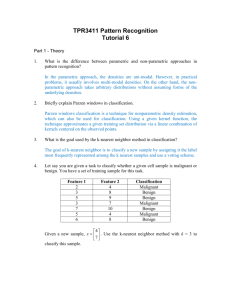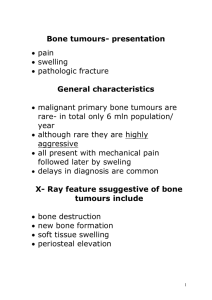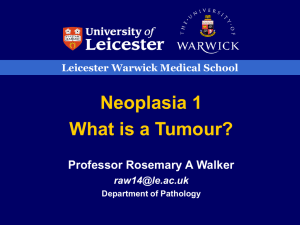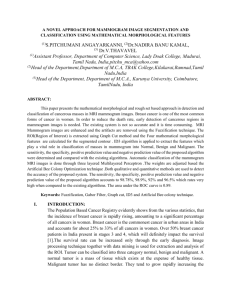Bone tumors 4312014-11
advertisement
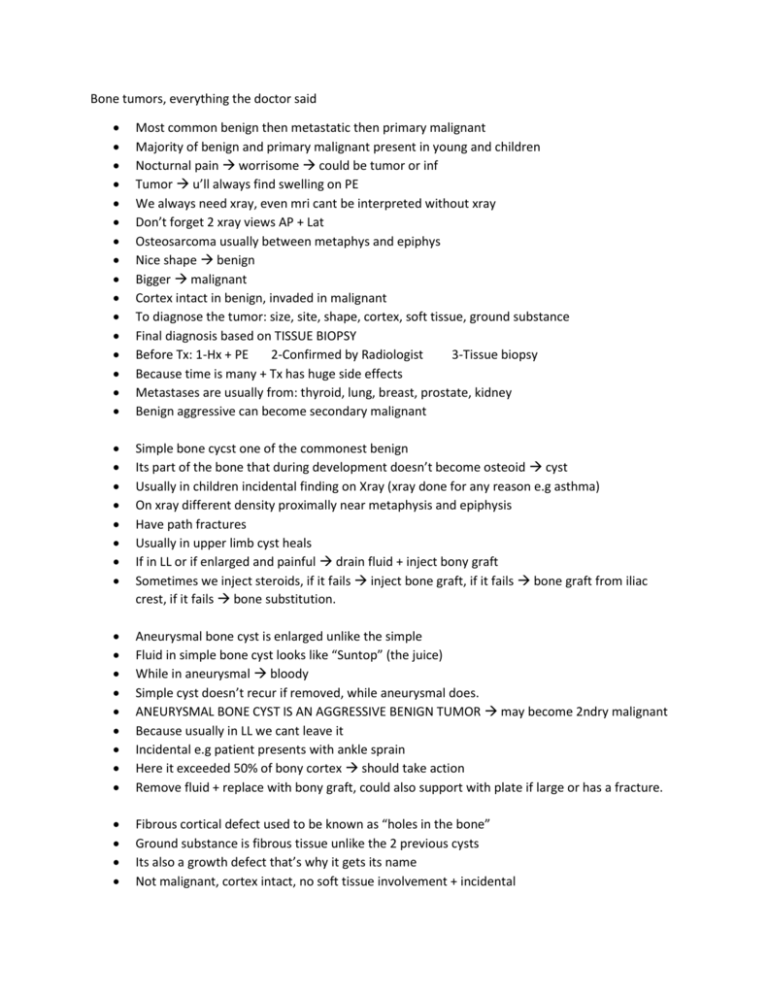
Bone tumors, everything the doctor said Most common benign then metastatic then primary malignant Majority of benign and primary malignant present in young and children Nocturnal pain worrisome could be tumor or inf Tumor u’ll always find swelling on PE We always need xray, even mri cant be interpreted without xray Don’t forget 2 xray views AP + Lat Osteosarcoma usually between metaphys and epiphys Nice shape benign Bigger malignant Cortex intact in benign, invaded in malignant To diagnose the tumor: size, site, shape, cortex, soft tissue, ground substance Final diagnosis based on TISSUE BIOPSY Before Tx: 1-Hx + PE 2-Confirmed by Radiologist 3-Tissue biopsy Because time is many + Tx has huge side effects Metastases are usually from: thyroid, lung, breast, prostate, kidney Benign aggressive can become secondary malignant Simple bone cycst one of the commonest benign Its part of the bone that during development doesn’t become osteoid cyst Usually in children incidental finding on Xray (xray done for any reason e.g asthma) On xray different density proximally near metaphysis and epiphysis Have path fractures Usually in upper limb cyst heals If in LL or if enlarged and painful drain fluid + inject bony graft Sometimes we inject steroids, if it fails inject bone graft, if it fails bone graft from iliac crest, if it fails bone substitution. Aneurysmal bone cyst is enlarged unlike the simple Fluid in simple bone cyst looks like “Suntop” (the juice) While in aneurysmal bloody Simple cyst doesn’t recur if removed, while aneurysmal does. ANEURYSMAL BONE CYST IS AN AGGRESSIVE BENIGN TUMOR may become 2ndry malignant Because usually in LL we cant leave it Incidental e.g patient presents with ankle sprain Here it exceeded 50% of bony cortex should take action Remove fluid + replace with bony graft, could also support with plate if large or has a fracture. Fibrous cortical defect used to be known as “holes in the bone” Ground substance is fibrous tissue unlike the 2 previous cysts Its also a growth defect that’s why it gets its name Not malignant, cortex intact, no soft tissue involvement + incidental If not painful follow up in 1 yr On year2 no change don’t come back unless something happens Osteoid osteoma one of the commonest Night pain, xray shows thickened cortex Small part “nidus” is what secretes bone , works more at night Happens anywhere in the body Give NSAID 6w-3m, if pain disappears nidus was targeted OO summary: common especially in young, sever pain, diagnosed using CT, Tx: medical if it fails go surgical. Enchondroma usually in digits, different from aneurysmal which happens in long bones Ground sub here contains fibrous tissue unlike aneurysmal which appears like glass Usually incidental finding, e.g fracture cast (no use) because tissue here is abnormal When sample taken turns out to be enchondroma Tx: curettage + bony graft and a small plate. ENCHONDROMATOSIS IS AN AGGRESSIVE BENIGN risk of 2ndry malignant Becomes multiple enchondromatosis (malignant) amputate to save life Osteochondroma: bone exostosis Usually in pelvis, around knee Increases with growth E.g. if around knee affects movement and tendons Presents with numbness xray shows additional bone compressing vessel remove it Or sometimes patient complains it became larger remove it NEVER EXCISE FOR COSMESIS If exam asks about indications for excision : NOT COSMESIS Types: pedunculated (has tail), sessile (like a dome) Tx: benign neglect if painless If painful, compressing neurovas bundle, affecting joint movement, sudden growth(suspecting malignancy) , in these cases excise GIANT CELL TUMOR BENIGN AGGRESSIVE Usually in 20-40yrs , a bit more in females Could happen in bone, soft tissue or tendon sheath You cant see the boundaries The image in the slides look malignant because it was ignored for too long, its considered malignant until proven otherwise using biopsy Tx: curettage + bony graft Primary malignant: Most common are 1- Ewing (young age grp) and 2-osteosarcoma (15-20y) 3- Multiple myeloma (40s) Orthos don’t treat MM, just and adjuvant role in case of fractures Ewing can even present at 1 or 2yrs Problem with ewing, mimics infection (pain, ↑ESR, ↑WBC, ↑bone scan, ↑gallium) and infection is more common Girl in the slides was first diagnosed with inf but showed no response to Abx biopsy showed ewing stage 2 parents not convinced, 6m later she came back with lung mets palliative Tx till she passed away. Osteosarcoma affects any age but usually 15yrs up to 40s. Types ما لكم دخل فيها. Image in slides shows tumor in tibia Xray shows “Sunburst” appearance + it left the bone and invaded soft tissue Ewing and osteosarcoma after Dx are give new adjuvant chemo (youre not required to know that) to shrink mass and kill micro mets. Before (in the 90s) they used to recommend amputation but now heading towards limb sparing. Doctor discussed the limb salvage procedure image (removal of the affected bone) Better to use the leg as a stick than amputation. Survival rate after new manamgent up to 85-90% Multiple myeloma usually elderly Skull xray Salt and pepper appearance Urine collection 24hrs diagnostic (Bence Jones Protien) Ortho role only adjuvant Bony lesion + patient > 40yrs think about mets Image in slides shows metastasis , why isn’t this a bony cysts? Because patient is 45yrs old its very unlikely that such a high tension joint survived a cyst for 45yrs without showing any problems. Workup showed renal cell carcinoma. Doctor’s summary: You have to know that we have benign tumors, benign aggressive and malignant. You have to know that the most common are benign then metastatic then primary malignant. You have to know the 3 benign aggressive tumors: Aneurismal, Enchondroma and Giant cell. The primary malignant tumors that you have to know are the Ewing, osteosarcoma and MM. This was done in less than an hour, it would be great if someone later organized this, and added images from the slides. The lect is much more superficial than what it in 430’s team work. Tareq Aljurf
